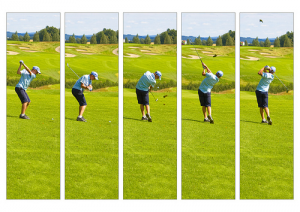 Most everyone who plays golf has a greater chance of low back injury. Recent study shows that about 35% of amateur and 22-24% of professional golfers susceptible to lumbar spine injuries. Collectively, the incidence of lower back pain in the male golfer is 25% to 36% and 22% to 27% in the female golfer. Many just want to learn how to hit the ball as far as possible and forgetting the basics of soft tissue trauma prevention. Below is the list of the risk factors that could cause lower back pain:
Most everyone who plays golf has a greater chance of low back injury. Recent study shows that about 35% of amateur and 22-24% of professional golfers susceptible to lumbar spine injuries. Collectively, the incidence of lower back pain in the male golfer is 25% to 36% and 22% to 27% in the female golfer. Many just want to learn how to hit the ball as far as possible and forgetting the basics of soft tissue trauma prevention. Below is the list of the risk factors that could cause lower back pain:
- Arthritis, disc injuries or stress fractures
- Weak abdominal musculature
- Poor muscle trunk stabilization and strength
- Poor warm up and flexibility
- Overuse or repetitive stress from technique
- Improper swing or technique
- Poor posture or scoliosis
- Age
- Overweight and general poor health
- Previous history of back pain or injury
What Is the Mechanism Injury of Lower Back While Playing Golf
Lumbar Spine consists of the following structures: vertebral bodies, IVD – Inter Vertebral Disc, Ligaments, Muscles and Tendons. Lower back injuries are the most common golf related injuries followed by, elbow, wrist and shoulder injuries. Occasionally golfers suffer from hip and knee pain as well. The most common mechanism of injury is the twisting and pulling that takes place during the golf swing against a spine that is not moving through its full range of motion. During golf swing the spine is exposed to extra load and tensile movement. It is estimated that during the swing phase the soft tissue of the lumbar spine is exposed to a force eight times of the body weight. Prolonger standing, twisting, and bending are the contributing factors for stress accumulation on the supporting structures of the lumbar spine. When the force dissipates through the vertebral body, muscles, discs and ligaments can be damaged and be the cause of low back injury.
Preventing Low Back Injuries from Golfing
- Less than 5% of amateur golfers fail to adequately stretch or warm up before the game. A proper warm up will provide the following benefits to the spine:
- Increasing circulation
- Increasing the range of motion
- Preparing for increased loading and stress
- Below is an example of good warm up activities:
- light jog or brisk walk, stretching the larger muscles or major muscle groups, swinging a club in both directions to mobilize the trunk muscles and increase circulation, Fluid, gentle practice swings preparing the relevant structures of the spine and muscles groups for the activity.
Improve Muscle Strength and Tone and Flexibility
Strengthening the abdominal and lower back muscles will help to stabilize the spine during the swing phase and in turn produce more powerful, longer shots. Strong quadriceps, buttock and hamstring muscles are another important key factor that should not be neglected. Here is link to a “Two Stretching Exercises for Golf Back Pain.” Pilates for Golfers (affiliate link) has been a very popular technique in preventing back injuries and elbow injuries while golfing. Pilates for Golfers is a step-by-step guide to identify and correct golf swing faults using the Pilates Method.
Consult Your Personal Chiropractor or Medical Professional
If you injured yourself while golfing, you must do the following in order to prevent farther injury:
- Discontinue any activities that aggravates the pain
- Apply ice to injured area ASAP – 15 minutes on and 45 minutes off
- After 72 hours you can switch to heating moist pads for increased blood flow
- Do not lye in bed for a prolonged period of time
- Force yourself for light activity
- Avoid Heavy Lifting
- Avoid Prolonged Sitting
- Avoid Prolonged Bending
- Suspend Golfing Activities
A visit to your local chiropractor would be a great benefit to your lower back pain. Make sure that your local chiropractor has physical therapy modalities such as, electric stimulation, moist heat, ultrasound, cold laser and certified massage therapist as a staff member. Spinal Chiropractic Adjustment can do wonders to your spine and overall well being.